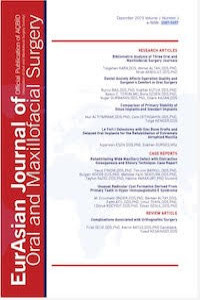Application of TMJ Prosthesis After Multicystic Ameloblastoma Resection: A Case Report
Application of TMJ Prosthesis After Multicystic Ameloblastoma Resection: A Case Report
ameloblastoma, reconstruction, temporomandibular prosthesis,
___
- 1. Brad W. Neville, D. D. S., Douglas D. Damm, D. D. S., Allen DDS MSD, C. & Angela C. Chi, D. Oral and Maxillofacial Pathology. (Elsevier Health Sciences, 2015).
- 2. Milman, T., Ying, G.-S., Pan, W. & LiVolsi, V. Ameloblastoma: 25 Year Experience at a Single Institution. Head Neck Pathol. 10, 513–520 (2016).
- 3. Mercuri, L. G. Condyle replacement after tumor resection: comparison of individual prefabricated titanium implants and costochondral grafts. Oral Surgery, Oral Medicine, Oral Pathology, Oral Radiology, and Endodontology vol. 108 153–155 (2009).
- 4. Sham, E. et al. Mandibular ameloblastoma: clinical experience and literature review. ANZ J. Surg. 79, 739–744 (2009).
- 5. Hayden, R. E., Mullin, D. P. & Patel, A. K. Reconstruction of the segmental mandibular defect: current state of the art. Curr. Opin. Otolaryngol. Head Neck Surg. 20, 231–236 (2012).
- 6. Carlson, E. R. Disarticulation resections of the mandible: A prospective review of 16 cases. J. Oral Maxillofac. Surg. 60, 176–181 (2002).
- 7. Fernandes, R., Fattahi, T. & Steinberg, B. Costochondral rib grafts in mandibular reconstruction. Atlas Oral Maxillofac. Surg. Clin. North Am. 14, 179–183 (2006).
- 8. Medra, A. M. M. Follow up of mandibular costochondral grafts after release of ankylosis of the temporomandibular joints. Br. J. Oral Maxillofac. Surg. 43, 118–122 (2005).
- 9. Quinn, P. D. & Granquist, E. J. Atlas of Temporomandibular Joint Surgery. (John Wiley & Sons, 2015).
- 10. Kashi, A., Saha, S. & Christensen, R. W. Temporomandibular joint disorders: artificial joint replacements and future research needs. J. Long Term Eff. Med. Implants 16, 459– 474 (2006).
- 11. Mercuri, L. G. Alloplastic temporomandibular joint reconstruction. Oral Surg. Oral Med. Oral Pathol. Oral Radiol. Endod. 85, 631–637 (1998).
- 12. Kryshtalskyj, B. Total prosthetic joint replacement for the end-stage of TMJ disease. Ont. Dent. 67, 25, 27–9 (1990).
- 13. Wolford, L. M., Mercuri, L. G., Schneiderman, E. D., Movahed, R. & Allen, W. Twenty-Year Follow-up Study on a Patient-Fitted Temporomandibular Joint Prosthesis: The Techmedica/TMJ Concepts Device. Journal of Oral and Maxillofacial Surgery vol. 73 952–960 (2015).
- Başlangıç: 2020
- Yayıncı: Ağız ve Çene Yüz Cerrahisi Birliği Derneği
Ömer EKİCİ, Mehmet Bilgehan PEKTAŞ
Angular Changes in Impacted Mandibular Third Molars in Young Adults
Göknur TOPALOĞLU YASAN, Hakan TUZ, Halil Tolga YÜKSEL, Kevser BÜLBÜL, Mine OĞUZCAN, Mina SHAHMARI
Maxillary Sinus Barotrauma with Infraorbital Nerve Paresthesia After Scuba Diving: A Case Report
Mehmet Zahit BAŞ, Semiha Seda ŞAHİN
Giant Cell Angiofibroma: A Rare Tumour in the Oral Cavity
Issa Al AZRI, Ahmed Al HASHMI, Hunaina Al KINDI, Mina GEORGE, Kaouther BACCOUCHE
Le Fort I Osteotomisi Uygulanan Hastalarda Cinch Süturun Burun Yumuşak Dokusuna Etkisi
Application of TMJ Prosthesis After Multicystic Ameloblastoma Resection: A Case Report
Ömer ERDUR, Muhammed Sefer AKKOÇ, Ahmet AKTI, Gökhan GÜRSES, Adil ERSOY
